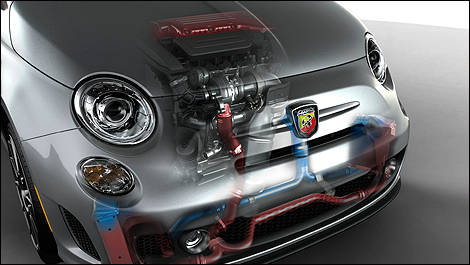Fiat’s 1.4L family of engines utilizes “MultiAir” technology. Dave Schmidt is chief engineer for Chrysler’s North American 1.4L engine program, and here’s how he described MultiAir to this writer, and now to you…
“An engine is basically just an air pump. Since the beginning of time for the internal combustion engine, the Holy Grail has always been efficient control of air into the combustion chamber. Over the last 100 years we’ve seen the evolution of overhead valves, overhead cams, dual overhead cams, variable valve timing and lift. Now we’ve taken things to a whole new level, with MultiAir.”
“Imagine a dual overhead cam valvetrain, and then completely remove the intake cam. But stick the cam lobes from that intake cam onto the single exhaust cam that’s left. And where that intake cam used to be, install a MultiAir unit.”
“Now instead of a direct mechanical linkage from the cam lobe to the intake valve, the cam lobe is pushing on a column of oil, to actuate the valve. The MultiAir unit has high-speed solenoids that control just how much of that lobe gets transferred to the valve itself. If we keep the solenoid valves closed, full lift is achieved; when the lobe comes around, it pushes the oil, and the valves open fully.”
“However, we can control the opening of these solenoids at any point in the cycle, thereby giving full variability to intake lift and duration, which gives us the precise air flow control we desire.”
“There are five basic modes in MultiAir: full lift; early intake valve closing; late intake valve opening; no lift; multi-lift. With that, we achieve the two desired outcomes: increased performance (horsepower and low-end torque), reduced fuel consumption and emissions.”
The 1.4L MultiAir engine in the 2012 Fiat 500 Abarth model is fitted with a single Honeywell turbocharger producing up to 18 psi in boost. Schmidt said it also received the following upgrades not found on the naturally-aspirated engine: forged steel crank, upgraded bearings, forged connecting rods, high strength pistons, full floating piston pins, oil squirters, integrated oil cooler module with cartridge style oil filter, precious metal tipped spark plugs, and stainless steel exhaust manifold.
The turbo also features a unique air induction system. Turbocharging compresses the air, so more air can get into the combustion chamber, but “charging” the air also heats it. Cooler air is better for combustion. To cool the charged air, Fiat engineers developed two coolers, located at each corner of the front fascia. There is also an “after run” cooling pump, to help cool down the turbocharger unit itself.
“An engine is basically just an air pump. Since the beginning of time for the internal combustion engine, the Holy Grail has always been efficient control of air into the combustion chamber. Over the last 100 years we’ve seen the evolution of overhead valves, overhead cams, dual overhead cams, variable valve timing and lift. Now we’ve taken things to a whole new level, with MultiAir.”
“Imagine a dual overhead cam valvetrain, and then completely remove the intake cam. But stick the cam lobes from that intake cam onto the single exhaust cam that’s left. And where that intake cam used to be, install a MultiAir unit.”
“Now instead of a direct mechanical linkage from the cam lobe to the intake valve, the cam lobe is pushing on a column of oil, to actuate the valve. The MultiAir unit has high-speed solenoids that control just how much of that lobe gets transferred to the valve itself. If we keep the solenoid valves closed, full lift is achieved; when the lobe comes around, it pushes the oil, and the valves open fully.”
 |
| Photo: Chrysler |
“However, we can control the opening of these solenoids at any point in the cycle, thereby giving full variability to intake lift and duration, which gives us the precise air flow control we desire.”
“There are five basic modes in MultiAir: full lift; early intake valve closing; late intake valve opening; no lift; multi-lift. With that, we achieve the two desired outcomes: increased performance (horsepower and low-end torque), reduced fuel consumption and emissions.”
The 1.4L MultiAir engine in the 2012 Fiat 500 Abarth model is fitted with a single Honeywell turbocharger producing up to 18 psi in boost. Schmidt said it also received the following upgrades not found on the naturally-aspirated engine: forged steel crank, upgraded bearings, forged connecting rods, high strength pistons, full floating piston pins, oil squirters, integrated oil cooler module with cartridge style oil filter, precious metal tipped spark plugs, and stainless steel exhaust manifold.
The turbo also features a unique air induction system. Turbocharging compresses the air, so more air can get into the combustion chamber, but “charging” the air also heats it. Cooler air is better for combustion. To cool the charged air, Fiat engineers developed two coolers, located at each corner of the front fascia. There is also an “after run” cooling pump, to help cool down the turbocharger unit itself.

